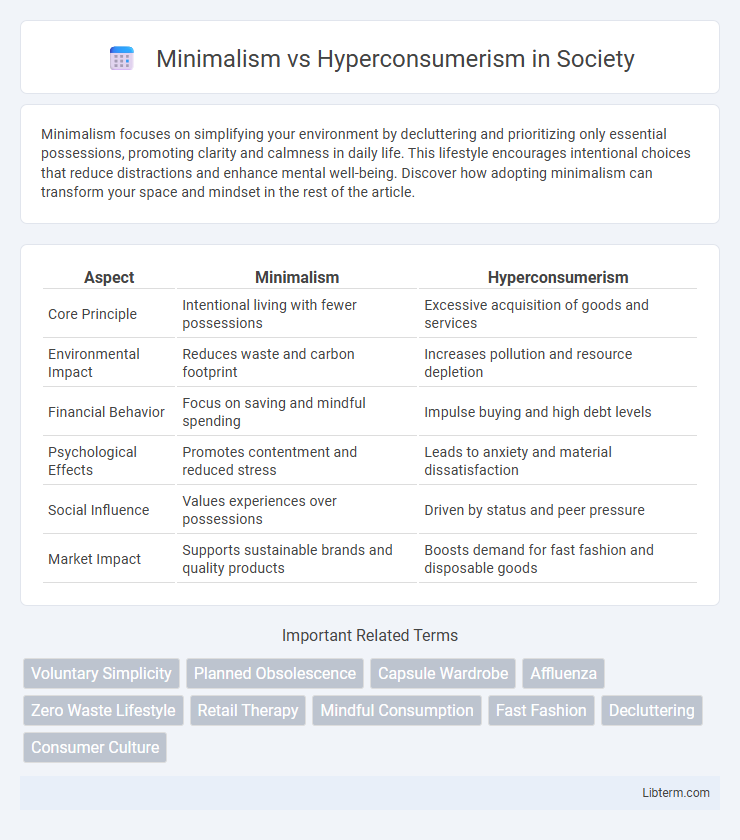Minimalism focuses on simplifying your environment by decluttering and prioritizing only essential possessions, promoting clarity and calmness in daily life. This lifestyle encourages intentional choices that reduce distractions and enhance mental well-being. Discover how adopting minimalism can transform your space and mindset in the rest of the article.
Table of Comparison
| Aspect | Minimalism | Hyperconsumerism |
|---|---|---|
| Core Principle | Intentional living with fewer possessions | Excessive acquisition of goods and services |
| Environmental Impact | Reduces waste and carbon footprint | Increases pollution and resource depletion |
| Financial Behavior | Focus on saving and mindful spending | Impulse buying and high debt levels |
| Psychological Effects | Promotes contentment and reduced stress | Leads to anxiety and material dissatisfaction |
| Social Influence | Values experiences over possessions | Driven by status and peer pressure |
| Market Impact | Supports sustainable brands and quality products | Boosts demand for fast fashion and disposable goods |
Understanding Minimalism: Principles and Practices
Minimalism emphasizes intentional living by prioritizing essential possessions and experiences to reduce clutter and stress. Core principles include mindful consumption, quality over quantity, and fostering contentment with less. Practices such as decluttering, simplifying daily routines, and conscious purchasing decisions support a sustainable and fulfilling lifestyle.
What is Hyperconsumerism? Signs and Symptoms
Hyperconsumerism is characterized by excessive consumption and an insatiable desire for acquiring material goods beyond basic needs. Signs include compulsive shopping, prioritizing possessions over experiences, and frequently replacing items despite their functionality. Symptoms often manifest as financial strain, cluttered living spaces, and diminished satisfaction from material wealth.
Historical Evolution: Minimalism and Consumer Culture
Minimalism originated as a reaction to excessive consumerism, gaining momentum in the 1960s as a cultural movement emphasizing simplicity and intentional living. In contrast, hyperconsumerism accelerated during the late 20th century, driven by globalization, mass production, and aggressive marketing strategies that promoted constant consumption and material acquisition. The historical evolution highlights a cyclical tension where minimalism seeks to counterbalance the environmental and social impacts of hyperconsumerism by advocating sustainable lifestyles and mindful purchasing habits.
The Psychological Impact of Minimalism
Minimalism reduces stress and anxiety by fostering a clutter-free environment that promotes mental clarity and emotional well-being. Research shows that individuals practicing minimalism report increased satisfaction and reduced decision fatigue compared to those engaged in hyperconsumerism. By prioritizing intentional consumption, minimalism enhances mindfulness and supports healthier psychological functioning.
The Social Consequences of Hyperconsumerism
Hyperconsumerism drives excessive materialism, fostering social inequality as wealth disparities become more pronounced through continuous consumption cycles. This culture encourages constant comparison and status anxiety, leading to decreased community cohesion and mental well-being. Environmental degradation also emerges as a consequence, disproportionately affecting vulnerable populations and exacerbating social tensions.
Minimalism vs Hyperconsumerism: Environmental Implications
Minimalism reduces environmental impact by promoting fewer purchases, less waste, and sustainable resource use, directly counteracting the excessive consumption patterns of hyperconsumerism that lead to pollution and resource depletion. Hyperconsumerism drives continuous demand for mass-produced goods, escalating carbon emissions, landfill growth, and unsustainable extraction of raw materials. Embracing minimalism supports eco-friendly lifestyles that diminish the ecological footprint and foster long-term planetary health.
Financial Freedom: Minimalist Spending vs Consumerist Debt
Minimalist spending emphasizes prioritizing essential purchases and reducing expenses to build savings and achieve financial freedom faster. In contrast, hyperconsumerism drives excessive buying fueled by credit, leading to mounting consumerist debt and financial strain. Sustainable wealth grows through mindful budgeting and minimizing debt, highlighting the stark financial consequences between minimalist habits and consumerist behaviors.
Digital Minimalism in a Hyperconnected Age
Digital minimalism emphasizes intentional technology use to reduce distractions and improve focus in today's hyperconnected age dominated by constant digital stimuli and social media overload. By prioritizing essential digital tools and setting boundaries, individuals combat hyperconsumerism-driven behaviors such as compulsive online shopping and endless content consumption fueled by targeted advertising algorithms. This minimalist approach fosters mental clarity, productivity, and a healthier relationship with technology amid pervasive digital noise and data saturation.
Minimalist Aesthetics vs Consumerist Trends: Home and Lifestyle
Minimalist aesthetics emphasize simplicity, functionality, and the use of neutral colors and natural materials to create calm and uncluttered home environments. Consumerist trends in home and lifestyle promote constant acquisition of the latest products, often characterized by bold colors, diverse textures, and high-tech gadgets designed to showcase status and abundance. The contrast lies in minimalism prioritizing quality and intentionality, while hyperconsumerism focuses on quantity and the pursuit of new, trendy items.
Choosing Your Path: Strategies for Intentional Living
Minimalism emphasizes purposeful living by prioritizing essential possessions and experiences, reducing clutter and financial stress. Hyperconsumerism promotes constant acquisition driven by trends and advertising, often leading to excess and short-term satisfaction. Choosing your path involves setting clear values, practicing mindful consumption, and aligning purchases with long-term well-being to foster intentional living.
Minimalism Infographic

 libterm.com
libterm.com